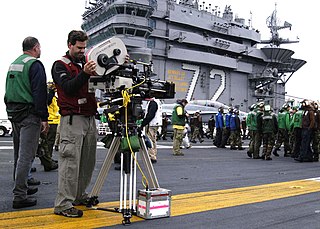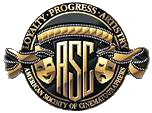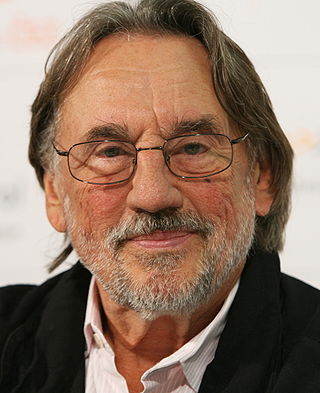
The cinematographer or director of photography is the person responsible for the recording of a film, television production, music video or other live-action piece. The cinematographer is the chief of the camera and light crews working on such projects. They would normally be responsible for making artistic and technical decisions related to the image and for selecting the camera, film stock, lenses, filters, etc. The study and practice of this field are referred to as cinematography.

Conrad Lafcadio Hall, ASC was a French Polynesian-born American cinematographer. Named after writers Joseph Conrad and Lafcadio Hearn, he became widely prominent as a cinematographer earning numerous accolades including three Academy Awards, three BAFTA Awards and five American Society of Cinematographers Awards.

The American Society of Cinematographers (ASC), founded in Hollywood in 1919, is a cultural, educational, and professional organization that is neither a labor union nor a guild. The society was organized to advance the science and art of cinematography and gather a wide range of cinematographers to discuss techniques and ideas and to advocate for motion pictures as a type of art form. Currently, the president of the ASC is Shelly Johnson.

Vittorio Storaro, A.S.C., A.I.C., is an Italian cinematographer widely recognized as one of the best and most influential in cinema history, for his work on numerous classic films including The Conformist (1970), Apocalypse Now (1979), and The Last Emperor (1987). In the course of over fifty years, he has collaborated with directors such as Bernardo Bertolucci, Francis Ford Coppola, Warren Beatty, Woody Allen and Carlos Saura.

Rodrigo Prieto Stambaugh, ASC, AMC, is a Mexican cinematographer and film director.

Vilmos Zsigmond was a Hungarian-American cinematographer. His work in cinematography helped shape the look of American movies in the 1970s, making him one of the leading figures in the American New Wave movement.

Sven Vilhem Nykvist was a Swedish cinematographer and filmmaker.
Alexander Phillips was a Canadian-Mexican cinematographer. He worked on over 200 films, most of them during the Golden Age of Mexican Cinema. Throughout his career, he was nominated 14 times for an Ariel Award for Best Cinematography which he won twice for En La Palma de Tu Mano and Untouched.
William Ashman Fraker, A.S.C., B.S.C. was an American cinematographer, film director and producer. He was nominated five times for the Academy Award for Best Cinematography. In 2000, he received a Lifetime Achievement Award from the American Society of Cinematographers (ASC) honoring his career. Fraker graduated from the USC School of Cinematic Arts in 1950.
Dante Spinotti, ASC, AIC is an Italian cinematographer. He is known for his collaborations with directors such as Michael Mann, Michael Apted, Ermanno Olmi, Bruce Beresford, Curtis Hanson, and Brett Ratner. He received Academy Award nominations for L.A. Confidential (1997) and The Insider (1999), and won a BAFTA Award for The Last of the Mohicans (1992). He has also won two Italian David di Donatello Awards and two Nastro d'Argento Awards.
Emmanuel Lubezki Morgenstern is a Mexican cinematographer. He has worked with many acclaimed directors, including Mike Nichols, Tim Burton, Michael Mann, Joel and Ethan Coen, David O. Russell, and frequent collaborators Terrence Malick, Alfonso Cuarón, and Alejandro González Iñárritu.
Dean William Semler ACS ASC is an Australian cinematographer and film director. Over his career, he has worked as a cinematographer, camera operator, director, second unit director, and assistant director. He is a three-time recipient of the AACTA Award for Best Cinematography and an Academy Award winner. He is a member of both the Australian Cinematographers Society (ACS) and the American Society of Cinematographers (ASC). In 2002 he was appointed a Member of the Order of Australia (AM).

Guillermo Jorge Navarro Solares, AMC, ASC is a Mexican cinematographer and television director. He has worked in Hollywood since 1994 and is a frequent collaborator of Guillermo del Toro and Robert Rodriguez. In 2007, he won the Academy Award for Best Cinematography and the Goya Award for Best Cinematography for del Toro's Pan's Labyrinth. His subsequent filmography runs the gamut from lower-budget arthouse and genre films to high-profile blockbusters like Hellboy, Zathura: A Space Adventure, Night at the Museum, and Pacific Rim.
Thomas Richmond was an American cinematographer who worked in the film industry since the mid-1980s. His first major feature film as cinematographer was Stand and Deliver (1988), and by the time he shot for A Midnight Clear (1992), he had settled into working with different directors with ease. Richmond described his experience, "All my films look different because they're not my visions; they're my reflections of the directors' visions." In 1998, he said he was most proud of his work on Little Odessa (1994), for which he was nominated an Independent Spirit Award for Best Cinematography. For Right at Your Door (2006), he won the Excellence in Cinematography Award (Dramatic) at the 2006 Sundance Film Festival.
The Centro de Capacitación Cinematográfica (CCC) is a film school belonging to Mexico's Secretariat of Culture. It was founded in 1975 with the aim of providing technical and artistic training for those entering the film industry. The CCC is part of the International Association of Film and Television Schools and since 2011 to the International Federation of Film Archives. Recognized as a cutting-edge school in film teaching, it received the Award for Academic Excellence at the Tel Aviv Film School Festival, in Israel, in 2005, and in 2006 the Golden Ariel for its 30 years of educational work and contribution to national cinema. It is one of Mexico's two major film schools, the other being the Centro Universitario de Estudios Cinematográficos at the National Autonomous University of Mexico.
Lula Carvalho, ASC is a Brazilian cinematographer.
Antonio Riestra, ASC, AČK., is a Mexican-born cinematographer, working in both North America and Europe. He won a Goya Award, and a Gaudí Award for Best Cinematography for his work on Augustí Villaronga's Black Bread.
Luis Gabriel Beristáin, ASC, BSC, AMC is a Mexican cinematographer, producer, and television director known for his work on numerous well-known films including The Distinguished Gentleman, The Spanish Prisoner, Blade II, and Street Kings, and several entries in the Marvel Cinematic Universe including the Agent Carter television series.
Florian Hoffmeister, B.S.C., is a German cinematographer and director, best known for his work on Tár, which earned him an Academy Award nomination for Best Cinematography. Projects he has worked on include Five Days, House of Saddam and AMC's The Terror. He has collaborated with director Terence Davies on two occasions, working on The Deep Blue Sea and A Quiet Passion. His other credits include In Secret, Mortdecai and Johnny English Strikes Again.
Alexis Zabé, AMC, ASC, is a Mexican cinematographer who studied at the Centro Universitario de Estudios Cinematográficos. He is best known for his work on films such as Silent Light and The Florida Project. Zabé is known to work frequently with directors Fernando Eimbcke and Carlos Reygadas. He is a member of both the Mexican Society of Cinematographers and the American Society of Cinematographers. Zabé is currently attached to several films including Erēmīta (Anthologies), directed by Sam Abbas.








